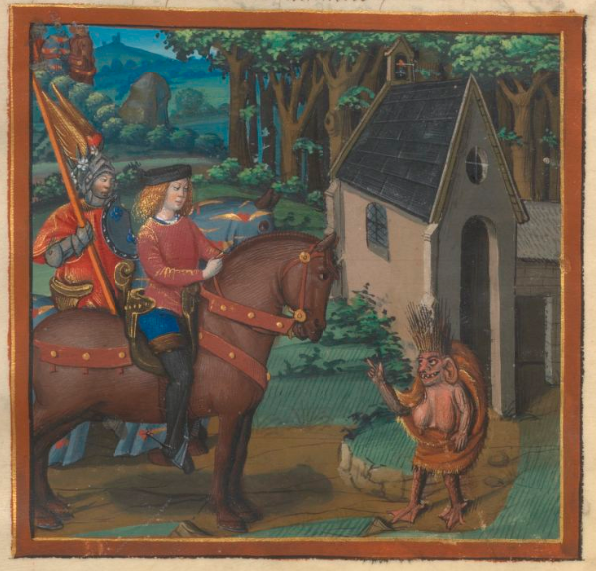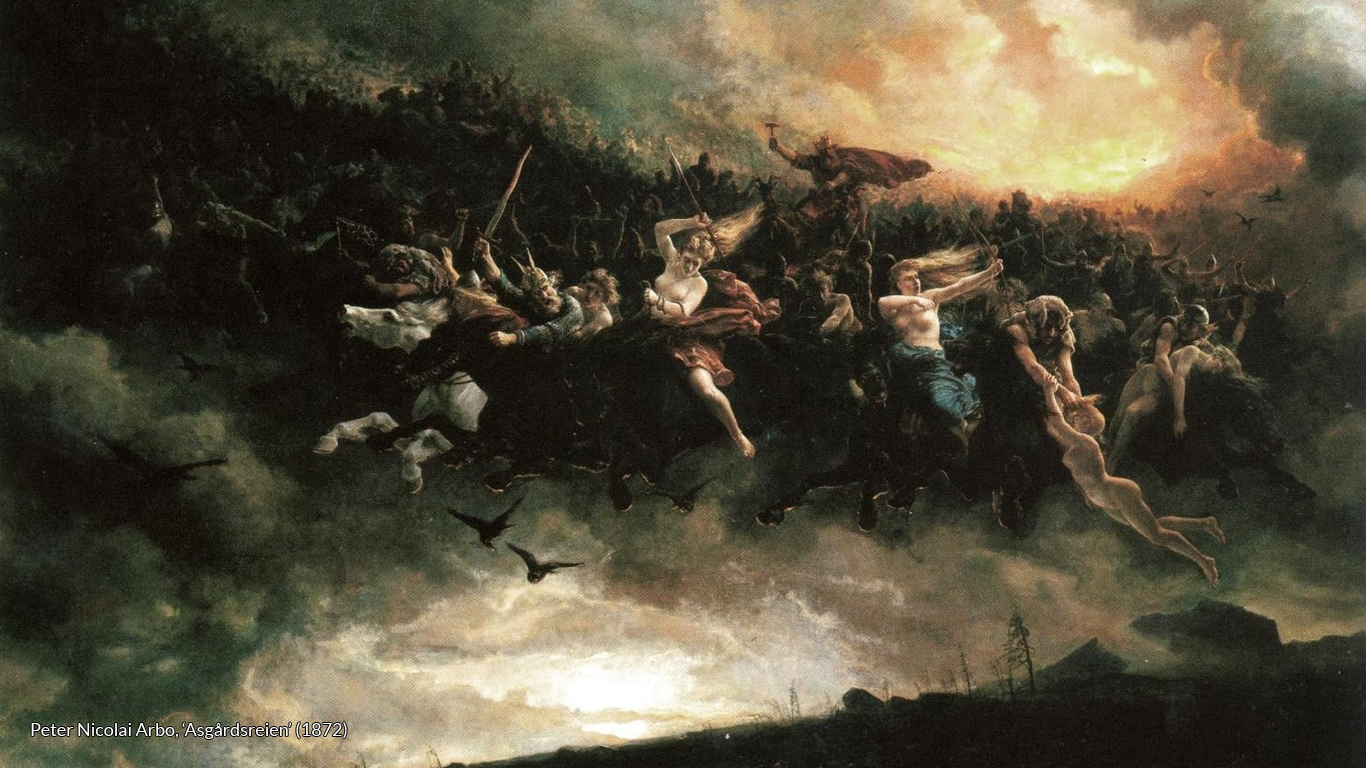The ghostly “Wild Hunt” rampaged across European folklore as a company of supernatural huntsmen that often counted fairies and the dead among their number. In England and Wales, tales of this strange hunting party go back to at least the twelfth-century. In this period, the Wild Hunt briefly appears in the Peterborough Chronicle and the writings of Oderic Vitalis, before being told by Walter Map in an extended tale that links the hunt to the ancient and cursed King Herla.
The Peterborough Chronicle records that a company of supernatural huntsmen appeared in 1127, in the days following Henry of Poitou’s unpopular installation as the new abbot of Peterborough Abbey:
[M]any men saw and heard many huntsmen hunting. The huntsmen were black and huge and loathsome, and their hounds all black and wide-eyed and loathsome, and they rode on black horses and on black billy goats. This was seen in the very deer-park of the town of Peterborough, and in all the woods there were from that same town to Stamford; and the monks heard the horns that they blew in the night… This was seen and heard from when [Henry of Poitou] came there, all that Lenten-tide right up to Easter.
It seems as if the land itself rises up in protest against the “unnatural” appointment of Henry of Poitou. The writer of this tale is certainly not shy in indicating who he wishes these huntsmen to hound out of Peterborough, proclaiming of Henry: “This was his entrance: of his exit we cannot yet say. May God provide!”
The English chronicler and Benedictine monk Oderic Vitalis also recorded an account of the Wild Hunt in the 1130s. He tells of a priest who one New Year’s night came across a mounted company of the dead, carrying “sheep, clothes, furniture and moveables”. Amongst their number, the priest saw a vast array of sinners being variously punished, from adulterous women, to fallen monks, deceitful lawyers, and “the assassin of Stephen the priest”. This assassin had been bound to a “immense trunk of tree” where a demon “goaded his loins and back with red hot spurs”. The priest declares, “doubtless these are the familia Herlechini; I have often heard of their being seen but I laughed at such stories.” As Ronald Hutton comments, it is clear that this version (along with several similar European Wild Hunt tales) arose from “growing speculation about the fate of the dead”, in a period that birthed the concept of purgatory as a physical place. Oderic’s tale also functions as a moral warning to the socially or religiously disruptive; it is no coincidence that he names several historical figures of the time being tortured amongst this company.

A more detailed and unique folkloric tale of the Wild Hunt and its origins can be found towards the end of the century, when Walter Map links the Wild Hunt to the ancient King Herla. Walter Map was a courtier from the Welsh Marches, whose sole surviving work is De Nugis Curialium (“Courtiers’ Trifles”) (c. 1182-91). This wonderfully strange book contains tales from history, satiric accounts of court life and an array of fantastical, often eerie folktales. Here, Map claims that numerous ghostly armies have been sighted across England and Wales, some charging through the sky and others roaming across the land. Of these, the best known is a silent, nocturnal company called the “Herlethingus”, who counted the dead among their number. They were said to slowly wander across the British Isles each night in a melancholy march, unable to ever find rest.
Map writes that the story of this cursed company began in the reign of the ancient British King Herla. One day, a dwarven king visited the court, requesting an audience. The dwarf was “gaily attired in a spotted fawn’s skin”, he had “a long red beard reaching to his chest”, “his belly was hairy and his legs ended in goats’ hoofs.” This strange king rode up to Herla “mounted on a large goat” and happily announced that Herla’s forthcoming wedding to a Frankish princess “should be brilliantly adorned by my presence as a guest”. He then decreed that, “I shall first attend your wedding and you mine on the same day a year hence”, and without waiting for a response, “he turned, and swifter than a tiger vanished from view.” This was a surprise to Herla, especially given that was not currently engaged to be married to anyone. Yet soon after the dwarf had departed, Frankish ambassadors arrived to propose just such a marriage and Herla quickly accepted. During the following wedding feast, the dwarven court provided a vast array of food and served all of the guests with such efficiency that Herla’s own servants were left “sat with their hands before them, neither called for nor offering aid.” The dwarves’ “splendid clothing and jewels made them shine like burning lights among the company: never importunate, never out of the way, they vexed no one by act or word.”
One year later, the dwarven king “suddenly appeared before Herla, and called on him to fulfil his agreement” by attending the dwarf’s own wedding. Herla quickly gathered the provisions for a feast and with several followers was led by the dwarf into a vast, deep cave in a high cliff. “After an interval of darkness” they passed into “a light which seemed to proceed not from the sun or moon, but from a multitude of lamps” and so entered “the mansion” of the dwarves. After the wedding, the dwarven king bestowed on Herla a vast array of gifts, but especially numerous were those of “horses, dogs, hawks, and every appliance of the best for hunting or fowling.” One of these gifts was a bloodhound and the dwarf warned Herla that none of his company should dismount from their horses “until that dog leapt from the arms of its bearer.” Thanking him, Herla’s court began their ride home.

On exiting the dwarf’s cave into the bright sun, Herla spied an old shepherd tending his flock. Riding up to him, Herla asked if the old man had heard any news of the Queen:
The shepherd gazed at him with astonishment and said: “Sir, I can hardly understand your speech, for you are a Briton and I a Saxon; but the name of that Queen I have never heard, save that they say that long ago there was a Queen of that name over the very ancient Britons, who was the wife of King Herla; and he, the old story says, disappeared in company with a pigmy at this very cliff, and was never seen on earth again, and it is now two hundred years since the Saxons took possession of this kingdom.
Herla sat stunned by this news. A few of his men began to dismount in shock, forgetting the dwarf’s warning concerning the bloodhound. As soon as their feet touched the ground, the men instantly turned into dust. Herla quickly ordered the rest of his men to stay mounted until the dog obliged them by leaping down.
But the dog never did leap down. The ages past and Herla’s company were condemned to a long, lonely march through time. Walter Map claims that they were “last seen in the marches of Wales and Hereford in the first year of the reign of King Henry II”, when Map was a boy of fifteen. At that time, Herla’s company were said to have been accosted by a large group of armed Welshmen, forcing the company to plunge into the river Wye, turn into air and vanish forever.
There is a historical subplot to this tale. Walter Map had his own reasons for linking Herla to Henry II, with one court beginning in the same year that the other disappears. In the pages proceeding the tale, Map describes at length the chaos of Henry II’s court. He compares the court to Hell and the courtier’s life to the eternal punishments of Tantalus, Sisyphus and Ixion. One passage sees Map proclaim:
In the Court I exist and of the Court I speak, and what the Court is, God knows, I know not. I do know however that the Court is … temporal … changeable and various, stationary and wandering, never continuing in one stay.
It is this combination of eternal punishment and perpetual wandering that then seems to remind Map of Herla and the Wild Hunt. He announces, “One Court and one only do stories tell of that is like our own”, before beginning his tale of the doomed King Herla and his court’s cursed and futile march across time. Once again, the folkloric Wild Hunt appears to be used as a symbol for political or spiritual disruption, held up as a ghostly mirror to reflect or correct real life chaos.
The Anglo-Saxon Chronicles, ed. & trans. Michael Swanton (London: Phoenix Press, 2000), p. 258
Ronald Hutton, ‘The Wild Hunt and the Witches’ Sabbath’, Folklore 125.2 (2014), 161-178
Walter Map, De Nugis Curialium, ed. & trans. M. R. James (London: The Honourable Society of Cymmrodorion, 1923), pp. 1-17, 206-7
Ordericus Vitalis, The Ecclesiastical History of England and Normandy, Vol. II, trans. Thomas Forester (London: Henry G. Bohn, 1853), pp. 511-20



